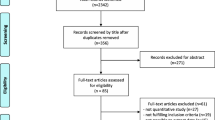Abstract
Purpose
General surgeons are at high risk for work-related musculoskeletal disorders (WRMSDs), especially in their neck and back. The prevalence and risk factors for surgeons’ WRMSDs in Japan have not been well surveyed.
Methods
A cross-sectional questionnaire survey on WRMSDs was conducted among general surgeons in Japan. Surgeons were asked about the presence and degree of neck, shoulder, and back disability in relation to open and laparoscopic surgery.
Results
The questionnaire was sent to 174 general surgeons in 21 hospitals and 106 (60.9%) responded. The prevalence of WRMSDs in the last month was 65.1%, and the prevalence at least once in a lifetime was 79.2%. The rate of WRMSDs of the neck and back was higher after open surgery (44.3%, 42.5%) than after laparoscopic surgery (28.2%, 31.1%), but there was no marked difference in shoulder pain. Age was the strongest risk factor for WRMSDs, and the pain scores, prevalence of chronic pain, and rate of WRMSD-related absence from work tended to increase with age.
Conclusion
A questionnaire survey of surgeons in Japan showed that about 80% of surgeons suffer from WRMSDs. Countermeasures for WRMSDs among surgeons are urgently desired to ensure that limited numbers of surgeons work in the operating theatre throughout their career.
Clinical trial registration
Registry name: a survey of surgeons’ musculoskeletal pain associated with performing surgery. University of Tsukuba Institutional Review Board registration number: 1519.


Similar content being viewed by others
References
Epstein S, Sparer EH, Tran BN, Ruan QZ, Dennerlein JT, Singhal D, et al. Prevalence of work-related musculoskeletal disorders among surgeons and interventionalists: a systematic review and meta-analysis. JAMA Surg. 2018;153: e174947.
Berguer R, Forkey DL, Smith WD. Ergonomic problems associated with laparoscopic surgery. Surg Endosc. 1999;13:466–8.
Davis WT, Fletcher SA, Guillamondegui OD. Musculoskeletal occupational injury among surgeons: effects for patients, providers, and institutions. J Surg Res. 2014;189:207-12.e6.
Cavanagh J, Brake M, Kearns D, Hong P. Work environment discomfort and injury: an ergonomic survey study of the American Society of Pediatric Otolaryngology members. Am J Otolaryngol. 2012;33:441–6.
Hemal AK, Srinivas M, Charles AR. Ergonomic problems associated with laparoscopy. J Endourol. 2001;15:499–503.
Liang B, Qi L, Yang J, Cao Z, Zu X, Liu L, et al. Ergonomic status of laparoscopic urologic surgery: survey results from 241 urologic surgeons in China. PLoS ONE. 2013;8: e70423.
Miller K, Benden M, Pickens A, Shipp E, Zheng Q. Ergonomics principles associated with laparoscopic surgeon injury/illness. Hum Factors. 2012;54:1087–92.
Park A, Lee G, Seagull FJ, Meenaghan N, Dexter D. Patients benefit while surgeons suffer: an impending epidemic. J Am Coll Surg. 2010;210:306–13.
Szeto GP, Ho P, Ting AC, Poon JT, Cheng SW, Tsang RC. Work-related musculoskeletal symptoms in surgeons. J Occup Rehabil. 2009;19:175–84.
The 9th Study Group about Work Style Reform of Doctors. https://www.mhlw.go.jp/content/10800000/000349216.pdf. Accessed 15 July 2021.
Voss RK, Chiang YJ, Cromwell KD, Urbauer DL, Lee JE, Cormier JN, et al. Do no harm, except to ourselves? A survey of symptoms and injuries in oncologic surgeons and pilot study of an intraoperative ergonomic intervention. J Am Coll Surg. 2017;224:16-25.e1.
Wauben LS, van Veelen MA, Grossot D, Goossens RH. Application of ergonomic guidelines durling minimally invasive surgery: a questionnaire survey of 284 surgeons. Surg Endosc. 2006;20:1268–74.
Mohseni-Bandpei MA, Ahmad-Shirvani M, Golbabaei N, Behtash H, Shahinfar Z, Fernández-de-las-Peñas C. Prevalence and risk factors associated with low back pain in Iranian surgeons. J Manipulative Physiol Ther. 2011;34:362–70.
Rambabu T, Suneetha K. Prevalence of work related musculoskeletal disorders among physicians, surgeons and dentists: a comparative study. Ann Med Health Sci Res. 2014;4:578–82.
Vaghela N, Parekh S, Ganjiwale D, Mehta JN. Work-related musculoskeletal disorder among surgeons in Gujarat. J Educ Health Promot. 2019;8:248.
Esposito C, El Ghoneimi A, Yamataka A, Rothenberg S, Bailez M, Ferro M, et al. Work-related upper limb musculoskeletal disorders in paediatric laparoscopic surgery. Multicent Surv J Pediatr Surg. 2013;48:1750–6.
Plerhoples TA, Hernandez-Boussard T, Wren SM. The aching surgeon: a survey of physical discomfort and symptoms following open, laparoscopic, and robotic surgery. J Robot Surg. 2012;6:65–72.
Szeto GP, Cheng SW, Poon JT, Ting AC, Tsang RC, Ho P. Surgeons’ static posture and movement repetitions in open and laparoscopic surgery. J Surg Res. 2012;172:e19-31.
Gundewall B, Liljeqvist M, Hansson T. Primary prevention of back symptoms and absence from work a prospective randomized study among hospital employees. Spine (Phila Pa 1976). 1993;18:587–94.
Mooney V, Kron M, Rummerfield P, Holmes B. The effect of workplace based strengthening on low back injury rates: a case study in the strip mining industry. J Occup Rehabil. 1995;5:157–67.
Park AE, Zahiri HR, Hallbeck MS, Augenstein V, Sutton E, Yu D, et al. Intraoperative “Micro Breaks” with targeted stretching enhance surgeon physical function and mental focus: a multicenter cohort study. Ann Surg. 2017;265:340–6.
Luger T, Rieger MA, Bonsch R, Krämer B, Seibt R, Steinhilber B. Active and passive work breaks during simulated laparoscopy among laparoscopic surgeons: study protocol for a controlled, randomised cross-over laboratory trial. BMJ Open. 2020;10: e038952.
Acknowledgements
The authors thank all the participants in this study.
Funding
No funding was received to conduct this study.
Author information
Authors and Affiliations
Corresponding author
Ethics declarations
Ethical approval
University of Tsukuba Institutional Review Board registration number: 1519.
Additional information
Publisher's Note
Springer Nature remains neutral with regard to jurisdictional claims in published maps and institutional affiliations.
Rights and permissions
About this article
Cite this article
Owada, Y., Furuya, K., Kim, J. et al. Prevalence of work-related musculoskeletal disorders among general surgeons in Japan. Surg Today 52, 1423–1429 (2022). https://doi.org/10.1007/s00595-022-02520-9
Received:
Accepted:
Published:
Issue Date:
DOI: https://doi.org/10.1007/s00595-022-02520-9




